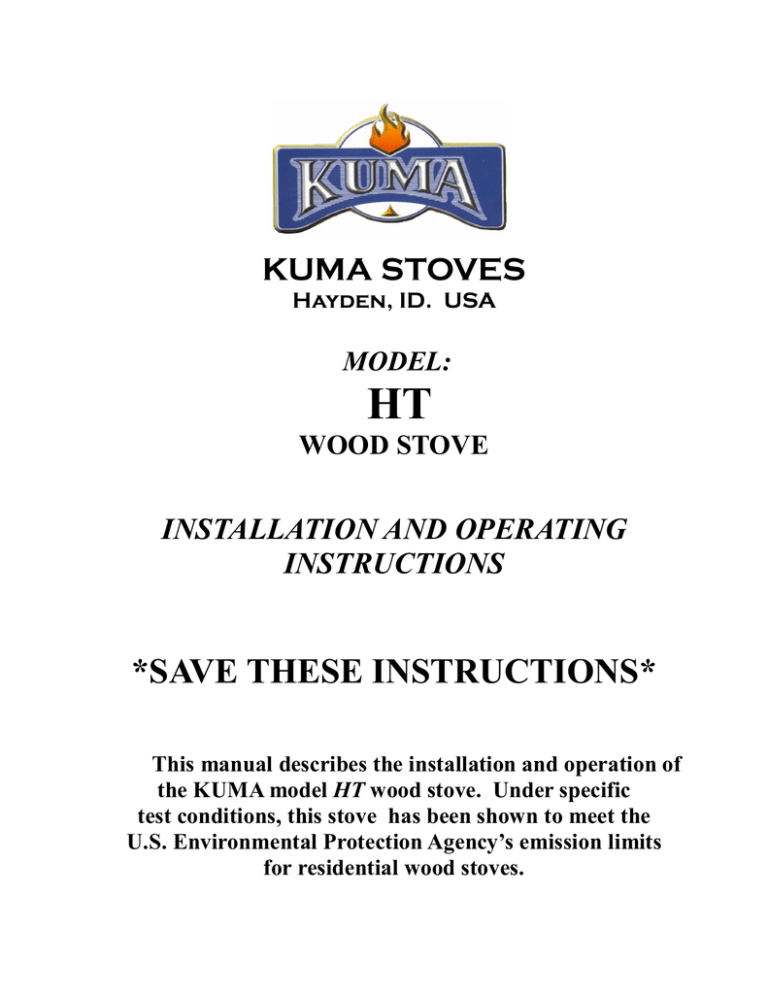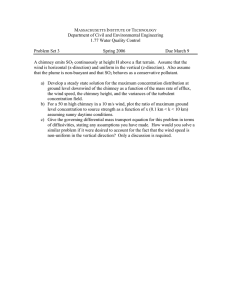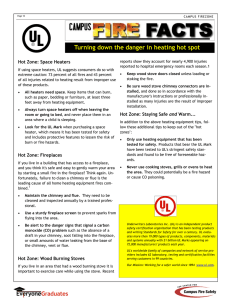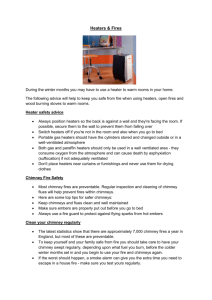SAVE THESE INSTRUCTIONS
advertisement

KUMA STOVES Hayden, ID. USA MODEL: HT WOOD STOVE INSTALLATION AND OPERATING INSTRUCTIONS *SAVE THESE INSTRUCTIONS* This manual describes the installation and operation of the KUMA model HT wood stove. Under specific test conditions, this stove has been shown to meet the U.S. Environmental Protection Agency’s emission limits for residential wood stoves. Please read the following safety precautions and the entire installation and operating instructions. SAFETY PRECAUTIONS 1. If this stove is not properly installed, a house fire can occur. For your protection, follow the installation instructions provided. We recommend contacting local building or fire officials regarding restrictions and installation inspection requirements in your area. We also recommend that your Kuma model HT wood stove be installed by a properly trained and licensed installer, preferably an NFI (National Fireplace Institute) expert. 2. DO NOT CONNECT THIS UNIT TO A CHIMNEY FLUE SERVING ANOTHER APPLIANCE. 3. Do not use gasoline, gasoline-type lantern fuel, kerosene, charcoal lighter fluid, or similar liquids to start or “freshen up” a fire in this heater. Keep all such liquids well away from the heater while it is in use. 4. Do not burn garbage. 5. Do not overfire. The stove is in an overfire position if any part of the stove glows. If this should happen, immediately close air damper. 6. WARNING: DO NOT INSTALL IN A SLEEPING ROOM. 7. Caution: The structural integrity of a mobile home floor, wall, and ceiling/roof must be maintained. 8. Do not use single-wall pipe for exterior chimney or mobile home applications. 9. When installing into an existing metal or masonry chimney, examine the chimney system carefully. If you have any questions, seek professional advice. DO NOT CONNECT THIS UNIT TO A CHIMNEY FLUE SERVING ANOTHER APPLIANCE. 10. Note all minimum clearances to combustibles. Installation must comply with minimum clearances as listed in this manual. 11. INSTALL AND USE IN ACCORDANCE WITH THE MANUFACTURER’S INSTALLATION AND OPERATING INSTRUCTIONS ONLY. 12. Safety Notice: If this heater is not properly installed, a house fire may result. For your safety, follow the installation directions. 13. Do not operate stove with firing door in an open position. 14. This room heater must be connected to a minimum 6” diameter listed chimney that complies with U.L. 103, HT-Type factory built chimney, or a code approved masonry chimney with a U.L. 1777 listed flue liner. 15. When connecting single-wall stove or double-wall listed chimney connector from the stove flue collar to the listed factory built chimney or masonry chimney, make sure all interconnecting joints of the flue pipe and the connection at the flue collar are secured with three (3) sheet metal screws. 16. When connecting this stove to a masonry chimney, make sure you observe all applicable clearances to combustible ceilings, walls, or other combustibles. A masonry chimney must be a 6” diameter minimum and constructed with a liner according to NFPA 211 code. If you are passing a chimney through a combustible wall to an outside chimney, use a U.L. 103, HT-Type approved insulated chimney section with a wall thimble, maintaining chimney to manufacturer’s listed minimum clearance to combustibles. When attempting to connect this stove into a masonry chimney use these steps: a. Chip out hole through masonry into liner at least 6” in diameter. b. Install stainless steel single-wall liner all the way into the masonry liner (see figure 2A). c. Seal or mortar stainless liner in with a refractory high-test type cement. d. Connect stove pipe into masonry hole. e. When passing through a combustible wall into masonry chimney, cut hole in wall large enough for the wall thimble, and use a U.L. 103, HT-Type insulated chimney section that directly connects into masonry liner described above (refer to figure 2A). CODES AND APPROVALS: The Kuma model HT wood stove is tested to UL, ULC, ICBO, HUD, and CSA standards and is listed with the Omni Test Labs, Inc. 1 MOBILE HOME INSTALLATION INSTRUCTIONS Model: HT Wood Stove CAUTION: THE STRUCTURAL INTEGRITY OF A MOBILE HOME FLOOR, WALL, AND CEILING/ROOF MUST BE MAINTAINED. CAUTION: DO NOT INSTALL IN A SLEEPING ROOM. Before you start, ensure that there are no major obstructions (i.e. floor joists, ceiling joists, electrical wires, heat ducts, plumbing, etc.). Clearance: backwall– 6”, corners– 4.5“, sidewall– 21” (using HT-Type listed chimney and double-wall connector). See figures 5 and 6. Consult your local building official and build your hearth pad to local building requirements. Typical hearth pad (see example: typical hearth pad on page 3)- 18” to front of unit, 6” to sides (hearth top must be non-combustible). Material required for installation: 4”outside air duct with screen, caulking to seal roof flashing, assorted nails and screws, 8-gauge ground wire, 3/8 lag bolts to fasten stove to the floor (length will depend upon hearth thickness). Tools required: saber saw, screwdrivers, measuring tape, pencil, plumb line, electric drill and assorted bits, tin shears, knife, pliers, hammer. 1. After locating possible obstructions (joists, pipes, etc.) and taking into account the necessary combustible clearances (fig.2), position the stove in the intended installation position. Use a plumb line to locate the position of the ceiling hole for the chimney. Size the chimney hole to the recommended manufacturer’s clearances for your chimney. Mark the hole. 2. Mark a pencil outline around the base of the stove. Move the stove out of the way. 3. Mark with a pencil the holes to be drilled to fasten the stove to the floor, then mark with a pencil a 4, 5, or 6” diameter hole for the fresh air intake. This hole may be positioned anywhere under the stove. If air through the wall is preferred, a dryer-type vent pipe should be installed from the wall to the 4” diameter hole at the pedestal base back. For your convenience, an outside air kit (part # 4OAVK) is available through your dealer. 4. If ceiling and floor are clear of all obstructions, cut out the holes (NOTE: Do not cut ceiling trusses). 5. In case of attic space use a plumb line to locate the hole in the roof. Cut out the opening, keeping in mind the chimney manufacturer’s recommended clearances. 6. Install the outside air duct to the floor using screws or nails. Ensure that your air duct has a screen or mesh to keep out rodents, etc. Air ducts must be at least 4” diameter. 7. Install a hearth pad 18” in front of the unit, 6” to the back, 6” to the sides according to local building codes or manufacturer’s specs (see applicable figures– corner or straight wall). 8. Position the stove on the hearth and if local code requires, bolt the stove securely to the mobile home frame. 9. For a list of typical chimney pipe parts, see figure 2. 10. Check all chimney pipe for damage. Do not use any damaged pipe. Installation procedures may vary from manufacturer to manufacturer of listed chimney. Install the chimney up through the hole in the ceiling and roof, observing pipe manufacturer’s minimum clearance to combustibles. 11. In cases where there is attic space, install a protective joist shield tube or box. Consult local building officials or chimney manufacturer. 12. Install the roof flashing, sealing water tight. Install the storm collar and seal water tight. Install chimney cap. NOTE: Refer to chimney manufacturer’s specs. Chimney height, see figure 7. Minimum for mobile home is 9 1/2’ above stove. 13. Install double-wall stove pipe connector from the stove to the chimney pipe, making sure to secure all joints of pipe together as well as the pipe to the stove flue collar with three sheet metal screws at each joint. 14. Call for final inspection. 15. INSTALL AND USE IN ACCORDANCE WITH THE MANUFACTURER’S INSTALLATION AND OPERATING INSTRUCTIONS ONLY. WHILE MOST ANYONE WITH BASIC CARPENTRY SKILLS CAN SUCCESSFULLY AND SAFELY INSTALL THEIR KUMA MODEL HT WOOD STOVE, IT IS HIGHLY RECOMMENDED THAT IT IS INSTALLED BY A QUALIFIED PROFESSIONAL WHO IS PROPERLY TRAINED AND LICENSED, PREFERABLY AN NFI (NATIONAL FIREPLACE INSTITUTE) EXPERT. YOUR STOVE IS NOW READY FOR USE. REFER TO OPERATING INSTRUCTIONS. 2 RESIDENTIAL INSTALLATION INSTRUCTIONS Model: HT CAUTION– Always read instructions before beginning the installation. Check all listed factory built chimneys for concealed damage. Exercise caution to ensure that all necessary parts are installed correctly. BEFORE YOU START ensure that there are no major obstructions (i.e. floor joists, ceiling joists, electrical wires, heat ducts, plumbing, etc.). Clearance- See figures 3 through 6. Consult your local building official and build your hearth pad to local building requirements. Use minimum 6” diameter black or “blued” steel chimney connector, 24 gauge minimum. EXAMPLE: Typical hearth pad (must be non-combustible at least 3/8” thick) 6” 6” 6” 18” NOTE: For residential installation, in which outside air intake is not desired, remove cover-plate at rear of pedestal base before installing stove as shown below. In this application, a hole through the floor is not required. Pedestal and base side view Remove air cover-plate at rear of unit. Non-combustible hearth pad. INSTALLATION 1. After locating possible obstructions (joists, pipes, etc.) and taking into account the necessary combustible clearances (fig. 2), position the stove in the intended installation position. Use a plumb line to locate the position of the ceiling hole for the chimney. Size the chimney hole to the recommended manufacturer’s clearances for your chimney. Mark the hole. 2. If the ceiling is clear of all obstructions, cut out the hole (NOTE: Do not cut the ceiling trusses.). 3. In case of attic space use a plumb line to locate the hole in the roof. Cut out the opening, keeping in mind the chimney manufacturer’s recommended clearances. 4. If outside air is desired or required by code, locate and cut a 4” diameter hole through the floor anywhere under the pedestal stove base. If air through the wall is preferred, a dryer-type vent pipe should be installed from the wall to the 4” diameter hole at the pedestal base back. A mesh-type screen should be installed to keep out rodents, etc. For your convenience, an outside air kit (part # 4OAVK) is available through your dealer. 5. Install a hearth pad according to local building codes or manufacturer’s specs (see above figure). 6. Position the stove on the hearth. 7. Check all chimney pipe for damage. Do not use any damaged pipe. Installation procedures may vary from manufacturer to manufacturer of listed chimney. Install the rest of the chimney up through the hole in the ceiling and roof. 8. In cases when there is an attic space, install a protective joist shield tube or box. Consult local building officials or chimney manufacturer. 9. Install the roof flashing, sealing water tight. Install the storm collar and seal water tight. Install chimney cap. NOTE: Refer to chimney manufacturer’s specs. Chimney height, see figure 7. 10. Install the stove pipe connector from the stove top to the chimney pipe, making sure to secure all joints of pipe together as well as the pipe to the stove flue collar with three sheet metal screws at each joint. 11. Call for final inspection. 12. Read completely the operating and burning instructions. Your wood stove is ready to burn. 3 WOOD BURNING OPERATING INSTRUCTIONS Model: HT Wood Stove RECOMMENDATIONS ON BUILDING AND MAINTAINING A FIRE: 1. Open air control by pulling draft handle all the way forward. 2. Start with tinder and small kindling. When starting a fire, stack wood in a “crisscross” arrangement so as to allow the fuel plenty of air. Place smaller chunks of wood, on up to larger ones until desired fire size and heat level is achieved. Once the desired heat level in house is reached, pushing the air control handle back in decreases the air to the firebox, and thus reduced heat produced. Use the following table as a general guideline for desired burn rates: Low-burn- Draft handle rotated back completely. Med-low- Draft handle full back to 1/4” forward. MediumDraft handle 1/4” to 1/2” forward. Med-high- Draft handle 1/2” to 3/4” forward. High burn- Draft handle rotated full forward. CAUTION: When building the first couple of fires, be careful to build the fire small and increase heat slowly over a 4-5 hour period. The paint on the stove “cures” with heat and needs to be done slowly. As the paint “cures” it gives off a smell of paint, and even sometimes a visible “smoky” haze into the room. Make sure the area is well ventilated during the curing operation. The smell will disappear after a few hours of operation. OPTIONAL BLOWER OPERATING INSTRUCTIONS: Install blower unit in back of stove as per instructions, and plug into nearest 115V grounded circuit. Turn the variable speed knob to ‘click’ onto high speed. As the knob is turned clock-wise, the blower speed decreases to your desired speed. The blower speed should match the desired burn rate on your stove: i.e. low-burn rate...low blower speed; high-burn rate… high blower speed and so forth. DO NOT OPERATE THIS STOVE WITH THE DOOR OPEN. It may be necessary, however, to crack the door for up to 5 minutes during the start-up stage. Contact your dealer if you have any questions or problems building or maintaining a fire. CAUTION: DO NOT USE CHEMICALS OR FLUIDS TO START OR FRESHEN UP A FIRE. DO NOT BURN GARBAGE OR FLAMMABLE FLUIDS SUCH AS GASOLINE, NAPHTHA, OR ENGINE OIL. 1. The unit is designed to burn wood only. Build the fire directly on the firebrick. Do not use grates. Your stove will burn better with about one inch of ash in the bottom. Your stove is a very efficient “airtight” heater and if you use high quality wood, there will be very little ash residue. 2. Use only the best grade of dry wood available. It takes a full year to properly dry your split wood, so plan ahead. Burning wet or green wood greatly increases the chance of creosote build-up and produces less heat. Store your fuel in a dry location and be sure to maintain clearances from the wood supply to your stove. 3. Small hot fires produce less creosote than long, low smoldering fires. When you start your stove or are re-kindling (reloading) your stove, open the draft fully and burn the stove at full burn for 20-30 minutes to heat up the chimney and secondary burn system. This ensures that when the draft control is rotated back for a lower, longer burn, the stove will burn cleaner. You should notice more upper firebox flame activity. This is smoke from the wood mixing with pre-heated air and burning. This is called secondary burn, and results in higher stove temperature at lower burn rates and less soot and creosote build-up. Just after starting the fire, some smoke may occur until the chimney warms up to produce some draft. During normal operation, adjust the draft to the position required. If properly set, it will assure longest burn times and the most even heat cycle. 4. Make routine inspections of your flue system at least once every two months to ensure clean, safe operation. 5. Ensure an adequate supply of outside combustion air is available. Failure to provide adequate combustion air is dangerous. Twelve (12) square inches minimum is recommended. 4 WOOD BURNING OPERATING INSTRUCTIONS (continued) CREOSOTE FORMATION AND NEED FOR REMOVAL: 6. When wood is burned slowly, it produces tar and other organic vapors which combine with expelled moisture to form creosote. The creosote vapors condense in the relatively cool chimney flue of a slow burning fire. As a result, creosote residue accumulates on the flue lining. When ignited, this creosote makes an extremely hot fire. If creosote has accumulated, it should be removed to reduce the risk of a chimney fire. DISPOSAL OF ASHES: 7. Ashes should be placed in a metal container with a tight-fitting lid. The closed container of ashes should be placed on a non-combustible floor on the ground, well away from all combustible materials, pending final disposal. If the ashes are disposed of by burial in soil or other wise locally dispersed, they should be retained in the closed container until all cinders have thoroughly cooled. 8. Maintain door seals, etc., to ensure airtight fit. Operate only with the fire door closed. Open door only to fuel fire. Do not operate the stove with the ash drawer open. 9. Resist the temptation to refuel too soon. Let the fire burn down to just glowing coals before you open the door. This will be the most efficient operation and there will be less smoking. Do not overfire. 10. Contact your local or provincial fire authority for information on how to handle a chimney fire. 11. For further information on using your heater safely, obtain a copy of the National Fire Protection Association publication: “Using Coal and Wood Stoves Safely.” NFPA No. HS-8-1974. The address of NFPA is: 470 Atlantic Ave., Boston, MA. 02210. GLASS DOOR 1. Never clean hot glass. 2. Clean with an approved cleaner. Never use an abrasive. 3. Excessive mechanical stress will crack or break the glass. Should breakage occur see your dealer or carefully remove retainer screws to release glass. Dispose of broken glass in a safe place. Replace the glass only with 5mm neoceram available from your dealer. Always replace the gasket with a glass replacement. Check glass after heater has been fired to ensure a tight seal. Tighten retainer just enough to provide the airtight seal. Uneven pressure from over-tightened screws will break the ceramic (glass). See figure 1. 4. Never build the fire up against the glass. 5. When closing the door, do not allow logs to protrude against the glass. 6. Your Kuma model HT wood stove is equipped with an airwash system that will self-clean the glass. If the glass is black or soot-covered from slow burning, simply load the stove with good dry split cordwood and burn at high burn for 20-30 minutes. The glass should burn itself clean. A WORD ABOUT DRAFT: The principle of draft is that warm air rises. Your chimney provides draft which sucks the smoke up the chimney. The stove does not “push” out the smoke. Your Wood Classic stove has been designed and approved for use under normal conditions. Unacceptable smoking usually indicates poor draft in your chimney system. CHECK THAT YOU HAVE PROVIDED FOR ADEQUATE OUTSIDE AIR FOR COMBUSTION, IF APPLICABLE. PROBABLE CAUSES FOR SMOKING ARE: 1. Insufficient chimney height above nearby obstructions. 2. Clogged or obstructed chimney system (in particular, plugged chimney cap screen) 3. Downdrafts caused by nearby trees, hills, buildings, etc. 4. NEGATIVE DRAFT: In a cold chimney, a cold air column rushing down the chimney can prevent stove start-up causing the wood stove or the chimney pipe joints to smoke. SOLUTION: Open a nearby window, and use small strips of newspaper or tinder loosely placed in the firebox that will provide quick and hot heat up the chimney, thereby reversing draft. Continue building fire. 5 Figure 3 Model: HT Wood Stove Backwall 16” Sidewall 19” 30” 21” Hearth pad MINIMUM CLEARANCES TO COMBUSTIBLES– STRAIGHT WALL CLASS C SINGLE-WALL CHIMNEY CONNECTOR 7 Figure 4 Model: HT Wood Stove Backwall 9.5” 18” Sidewall 9.5” 18” Hearth pad MINIMUM CLEARANCES TO COMBUSTIBLES– CORNER CLASS C SINGLE-WALL CHIMNEY CONNECTOR 8 Figure 5 Model: HT Wood Stove Backwall 6” Sidewall 8.5” 30” 21” Hearth pad MINIMUM CLEARANCES TO COMBUSTIBLES– STRAIGHT WALL HT-TYPE LISTED CHIMNEYS USING APPROVED DOUBLE-WALL CONNECTOR 9 Figure 6 Model: HT Wood Stove Backwall 4.5” 12.5” Sidewall 4.5” 12.5” Hearth pad MINIMUM CLEARANCES TO COMBUSTIBLES– CORNER HT-TYPE LISTED CHIMNEYS USING APPROVED DOUBLE-WALL CONNECTOR 10 HEIGHT REQUIREMENTS A chimney must be the required height above the roof or other obstruction for safety and for proper draft operation. The requirement is that the chimney must be at least 3’ higher than the highest point where it passes through the roof and at least 2’ higher than the highest part of the roof or structure that is within 10’ of the chimney, measured horizontally (figure 7). Figure 7 2’ minimum 3’ minimum 10’ WARRANTY Limited Lifetime Warranty Your Kuma model HTwood stove, manufactured by Kuma Stoves, is warranted against defects in materials or workmanship according to the following: Stove body/all welded steel components– Lifetime to the original purchaser. Burning system (stainless steel baffle components)- 5 years Electrical components are warranted for 1 year from the date of purchase. Warranty does not cover gold, brass, or nickel items, glass, or normal maintenance items such as paint, gasket, or firebrick. This warranty does not apply or cover in cases of abuse, mishandling, unauthorized repair, or alterations, failures, or operating difficulties due to misuse, accident, improper installation, improper maintenance or improper service. Kuma Stoves reserves the right under this warranty to repair, replace, or authorize repair of a defective stove or part at their discretion. Any warranty concern should be directed to your dealer, who will contact us. 11 Ash Pan Operating Instructions: Safety Precautions 1. Do not operate your wood stove with the ash pan open or removed. 2. Empty the ash pan when the fire is at its lowest point or out. 3. NEVER empty ashes into a combustible container (paper bag, plastic bucket, etc.) 4. NEVER leave ashes in the house or garage. Ashes that seem to be cool may not be. 5. Check gasket on ash pan periodically to ensure a good seal. Operation 1. Wait until the fire is at its lowest point or out. 2. Remove the ash pan by turning the handle and pulling out. 3. Take the ash pan outside and dump the ashes into a metal or other non-combustible container. 4. Before replacing the ash pan, check to see if any ashes need to be removed from the ash pan plenum. If any significant amount of ashes remain in the ash plenum, it will prevent the ash pan from sliding all the way in and it may not seal, resulting in air entering the ash grate which will produce a runaway fire. 5. Replace the ash pan by inserting it back into the stove, pushing in on the handle while in the horizontal position, and turning to the straight up and down position (spring pointed down).


